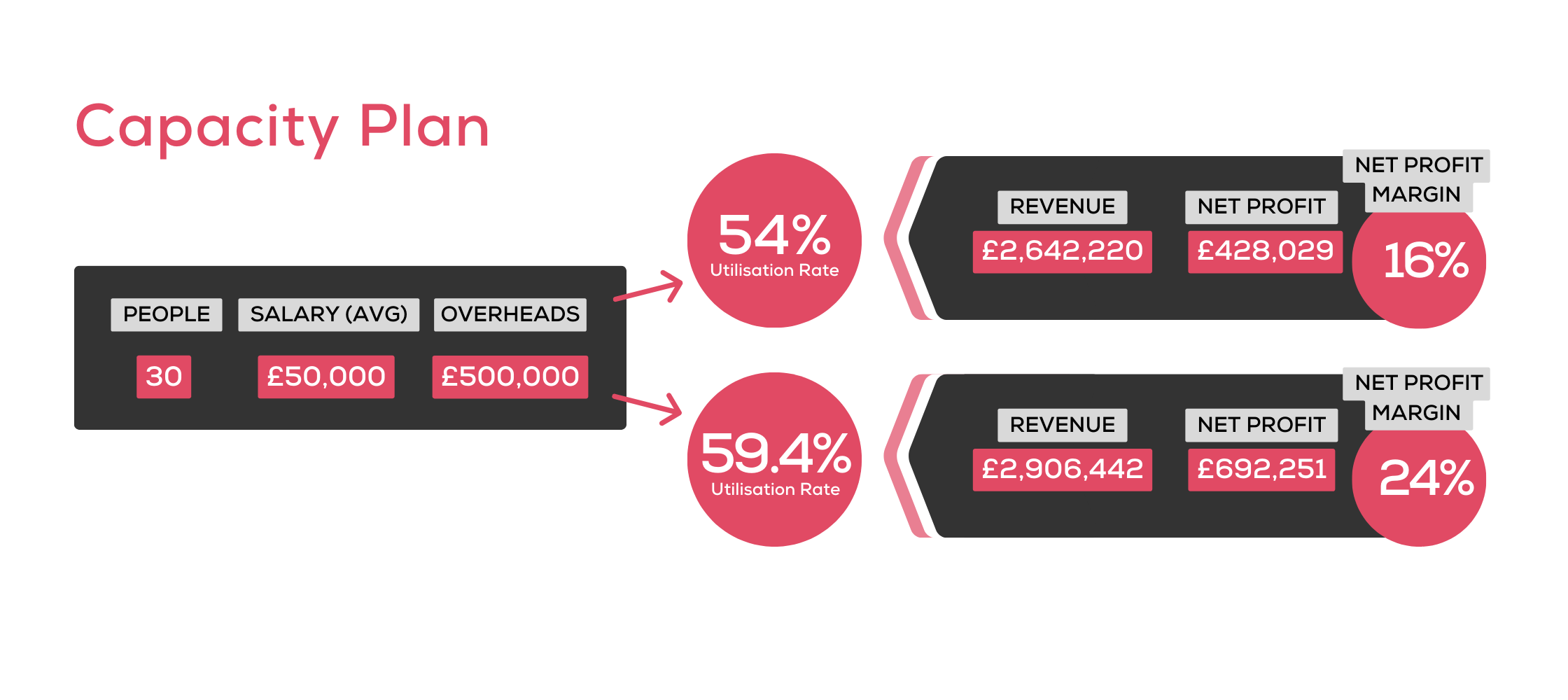Running a successful Digital Agency isn’t just about providing cutting-edge services; it’s about ensuring that your business model aligns with the size and shape that maximises efficiency and profitability. In this blog post, we’ll delve into key considerations for building a business that makes sense, focusing on team size, revenue potential, and the crucial role of a Capacity Plan model.
1. Team Size vs. Revenue Generation: Balancing Act
– Diagnosing Problems and Opportunities: The success of a Digital Agency hinges on finding the right equilibrium between team size and revenue generation. This requires a meticulous diagnosis of both the makeup of your team and your potential revenue streams. Identifying issues and opportunities early on sets the stage for a strategic and sustainable business model.
– Bloat vs. Burnout: One common challenge is understanding the delicate balance between having a team that is too large, resulting in bloat and squeezed profit margins, and a team that is too small, leading to burnout, compromised quality, and potential team attrition. The first step in addressing this challenge is a comprehensive diagnosis.
2. Understanding the Revenue Model: Time for Money
For many service-based businesses, time is the core selling point. Digital Agencies often sell their expertise and creativity in the form of time for money. Understanding this model is foundational to making informed decisions in the short and long term.
Regardless of the pricing strategy (time and materials, fixed fees, or value pricing), your team is the biggest cost. The revenue model must cover the cost of their time, overhead, and provide a margin for consistent profitability.

3. Building a Capacity Plan Model: Practical Steps
A capacity plan serves as a key planning tool in a service business, offering a structured approach to assessing and optimising your team’s potential for revenue generation.
In essence, a capacity plan is a dynamic tool that allows agencies to align their workforce with the demands of their workload. It goes beyond mere headcounts, providing a detailed breakdown of each team member’s role, availability, and potential for chargeable client work.
By crafting a robust capacity plan, agencies gain a clear understanding of their team’s capacity, allowing for informed decision-making, resource allocation, and revenue forecasting.
 In this illustration, a 10% increase in utilisation results in an additional £262,222 on the bottom line.
In this illustration, a 10% increase in utilisation results in an additional £262,222 on the bottom line.
Now, let’s delve into the practical steps involved in building a comprehensive Capacity Plan model for your Digital Agency.
List Employees by Role: Create a comprehensive list of all employees in your business, categorised by role.
Enter Salaries and Working Days: Input employee salaries, working days per year, holidays, and other time off.
Assign Utilisation Rates: Define the proportion of time each role can be expected to spend on chargeable client work.
Calculate Net Billable Days: Compute the net “billable” days for each employee, considering their availability for client work.
Enter Day Rates: List each employee’s day rate, considering blended rates or variations based on roles.
4. Analysing the Revenue Model: Profit per Employee
Compute Total Revenue Capacity: Calculate the total revenue capacity per month and year based on the listed team.
Evaluate Profit per Employee: Focus on the profit per employee rather than revenue to understand the overall profitability of each role.
Identify Opportunities and Challenges: Analyse the model to identify areas of strength, resource gaps, and potential revenue generation opportunities.
5. Taking Action: Leveraging Insights
Addressing Imbalances: Act on insights gained from the model. Adjust team sizes in specific roles or seek additional revenue based on your team’s capacity.
Exploring Revenue Streams: Explore revenue opportunities within your existing client base and seek the right type of revenue based on your team’s capabilities.
Consulting with Experts: Book a session with one of our team to discuss and stress-test your model.
Building a Digital Agency that makes sense involves a careful balance between team size and revenue generation.
By leveraging a Capacity Plan model, you gain clarity on your team’s potential, identify opportunities for growth, and ensure a profitable and sustainable business model.
Don’t just run your agency – model it for success.







